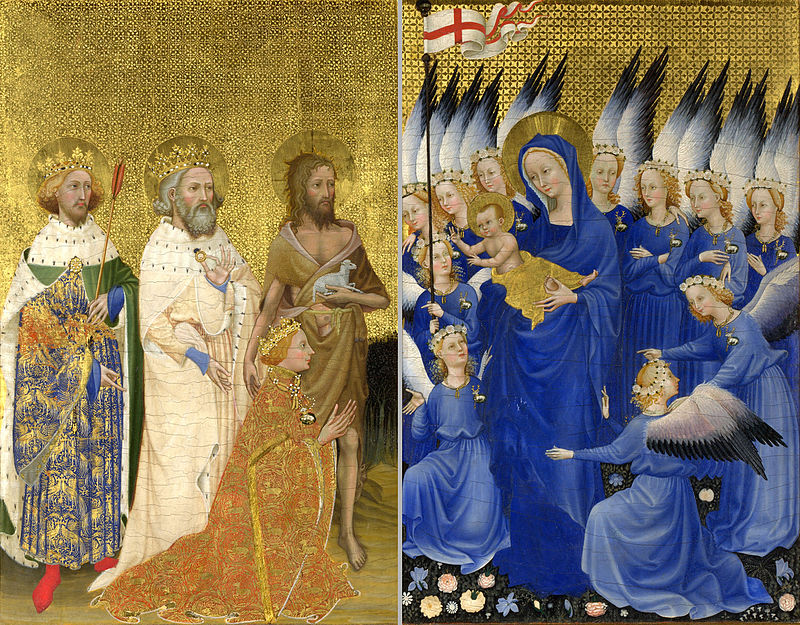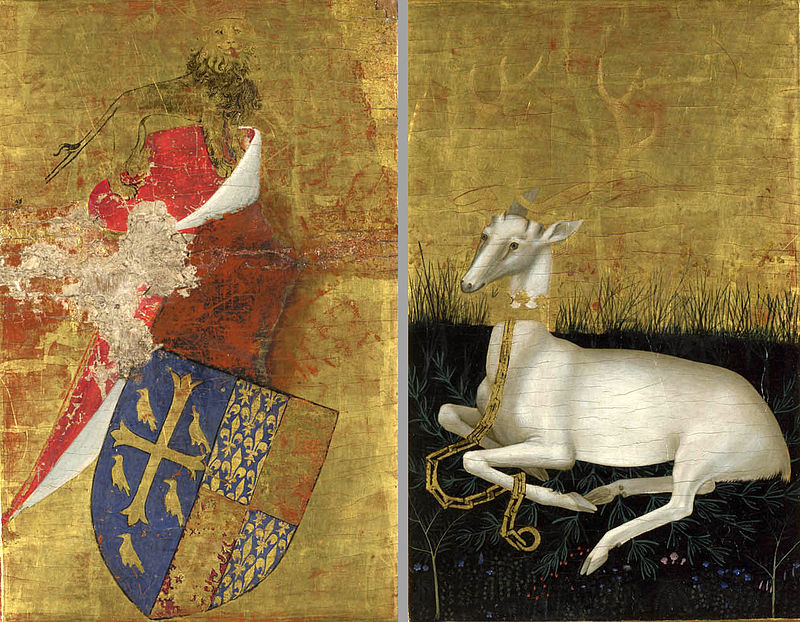The Wilton Altarpiece is an important example of a Northern European altarpiece, reflecting the artistic and religious traditions of the region during the late medieval and early Renaissance periods. As an altarpiece, it was intended to serve as the centerpiece of a church or chapel, conveying religious narratives and fostering devotion among the faithful.
The Wilton Diptych is painted on two panels of Baltic oak, set in frames of the same material and joined by two hinges so that it may be closed to protect the inner painting. The inner faces of the panels are in excellent condition for their age, though some glazes have been lost, and the outer faces have paint losses from handling.
The painting is in tempera, the ground paint being mixed with egg yolk and laid in thin glazes. The background and many details are inlaid with gold leaf and in places the panel has been tooled beneath the gilding to enhance the decorative quality. In the panel with the Virgin and Christ Child, the garments are universally blue, the pigment coming from the semi-precious stone lapis lazuli. Richard’s robe uses vermilion, another expensive pigment. Some colours have faded; the roses in the angels’ hair would originally have been a much deeper pink, and the green grass of the outer hart panel is now much darker than when painted.
Although the figures of the two inner scenes face each other, and interact by gaze and gesture, they are set in different backgrounds. The human figures are on bare rocky ground, with a forest behind, and a gold leaf “sky” decorated with a pattern made by a metal punch. The heavenly figures stand in a flowery meadow, behind which is a gold background patterned by a different punch.

The Wilton Diptych, c. 1395–1399. Each panel is 53 cm (21 in) x 37 cm (15 in). National Gallery, London.
In the left inner panel the kneeling King Richard II is presented by Saints John the Baptist, Edward the Confessor and Edmund the Martyr, each holding their attribute. In the right-hand panel the Virgin Mary with the Christ Child in her arms is surrounded by eleven angels, against a golden background and field of delicately coloured flowers.
Richard’s outer robe is of cloth of gold and red vermilion, the fabric decorated with his personal device of the white harts and sprigs of rosemary, the emblem of his wife Anne of Bohemia, who died in 1394. Around his neck is a gold collar with broomscods, seed-pods of Cytisus scoparius, the common broom, which is the planta genista that gave Richard’s Plantagenet dynasty its name. They were also the emblem of Charles VI of France, whose daughter he married in 1396. Richard had been given such a collar by Charles in 1393, and wearing one here may indicate a date for the work after Richard’s second marriage to the six-year-old Isabella of Valois in 1396. The livery badges worn by both Richard and the angels appear to be made in the fashionable and expensive technique of ronde bosse white enamel on gold; they are comparable to the surviving Dunstable Swan Jewel, probably given by one of Richard’s cousins in the House of Lancaster. Richard’s badge, but not those of the angels, has pearls tipping the antlers, and may perhaps be based on one of several examples recorded in his treasure roll of 1397, which had pearls and a bed of emeralds for the hind to sit on. A hart badge of Richard’s inventoried in the possession of Duke Philip the Good of Burgundy in 1435 was set with 22 pearls, two spinels, two sapphires, a ruby and a huge diamond.

The Wilton Diptych, c. 1395–1399. Each panel is 53 cm (21 in) x 37 cm (15 in). National Gallery, London.
In terms of style, the Wilton Altarpiece exhibits characteristics common in Northern European art of the time. The figures are portrayed with a high degree of naturalism, emphasizing individualized facial features and attention to detail. The use of vibrant colors and meticulous rendering of textures, such as the delicate folds of clothing, further exemplify the meticulous craftsmanship associated with Northern European painters.
Northern European altarpieces like the Wilton Altarpiece played a crucial role in the religious and cultural life of the communities they were created for. They functioned as focal points of devotion and served as aids for contemplation and prayer. The movable panels allowed for a varied display of religious narratives, enabling the faithful to engage with different aspects of their faith.
Furthermore, altarpieces such as the Wilton Altarpiece often incorporated complex iconography and symbolism, making them educational tools for the illiterate or less educated members of society. Through visual storytelling, these altarpieces conveyed biblical stories and theological concepts, reinforcing religious teachings and fostering a deeper understanding of the faith.
In conclusion, the Wilton Altarpiece stands as a noteworthy example of a Northern European altarpiece. Its emphasis on naturalism, relatable portrayals of religious figures, and the inclusion of narrative scenes demonstrate the distinctive characteristics of Northern European religious art during the late medieval and early Renaissance periods. These altarpieces were not only artistic masterpieces but also played a vital role in shaping the religious and cultural landscape of Northern Europe.
